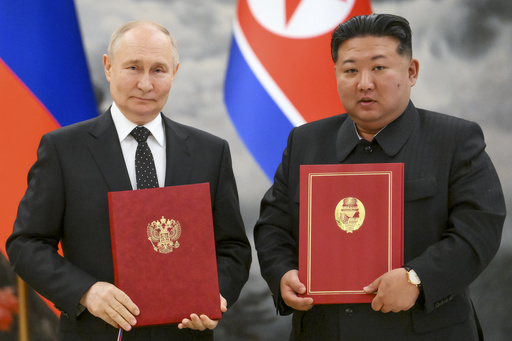Both Russian President Vladimir Putin and North Korean leader Kim Jong Un say the strategic partnership they signed Wednesday is a breakthrough. But neither side has released the text of the agreement that resulted from their summit in Pyongyang, and its consequences for the near and long terms are uncertain.
Relations between sprawling Russia and small, isolated North Korea — both of them nuclear powers — have warmed significantly in recent years amid Russia’s growing acrimony with the West over the invasion of Ukraine and suppression of all domestic opposition.
The new agreement could bring them even closer, while also posing new challenges to the international community.
What’s in the new partnership, according to Kim and Putin:
What defines aggression?
Putin told a briefing after the signing that “the comprehensive partnership agreement provides, among other things, for the provision of mutual assistance in the event of aggression against one of the parties to this document.”
That sentence raises an array of questions.
The first is what might be considered “aggression.” Both parties historically have used the word to denounce actions that fall far short of a physical attack, or even a cyberattack.
North Korea takes an especially broad view. Pyongyang commonly terms the combined military exercises held between the United States and South Korea as “aggression,” describing them as invasion rehearsals. It often conducts its own missile tests or other military displays as part of a tit-for-tat retaliation.
Nor do the so-called aggressions need to be actual actions. It has denounced U.S. criticism of North Korea’s human rights record as “the main means of aggression, together with military threat, (that) the DPRK will have to take into consideration the resolute and decisive option for defending the sovereignty and security of the state in an all-round way.” The country’s formal name is the Democratic People’s Republic of Korea, or DPRK.
Russia has predicated the war in Ukraine on purported plans by NATO to commit aggression against Russia from its neighbor. Putin also once called the 2014 demonstrations that ousted Ukraine’s Russia-friendly president as aggression
What would be the response?
The kind of support pledged in the agreement was not spelled out, unlike the Article 5 clause of the NATO charter that requires member nations to take the action they deem necessary.
In their explanations of the agreement, neither Putin nor Kim said whether it specified if the assistance would be troops, materiel or some other sort of aid.
What if there’s no aggression?
North Korea and Russia may not find reason to claim any commission of aggression against them, but they say they will help each other’s militaries.
Putin essentially linked such military cooperation with North Korea to Western supplies of weapons to Ukraine, referring to high-precision weapons systems, warplanes and other high-tech weapons.
“The Russian Federation does not exclude the development of military-technical cooperation with the Democratic People’s Republic of Korea in accordance with the document signed today,” Putin said.
That statement in effect formalizes what Western countries claim is already happening.
The U.S. and other allies allege that Russia has received ballistic missiles and ammunition from North Korea as the Ukraine war depletes Moscow’s inventory, and that Russia has made technology transfers to Pyongyang that could enhance the threat posed by Kim’s nuclear weapons and missile program.
What’s the economic aspect of the pact?
The partnership also calls for developing economic ties, an especially important issue for North Korea as it suffers under an array of international sanctions. North Korea needs goods and material, and in turn can supply Russia’s war-depleted workforce with labor; those workers in turn could convert wages in rubles to dollars or euros and send hard-currency back home.
Putin said the Russian-North Korean trade turnover has risen ninefold over the past year, but admitted that the amount itself remains “modest.”
Source: post





